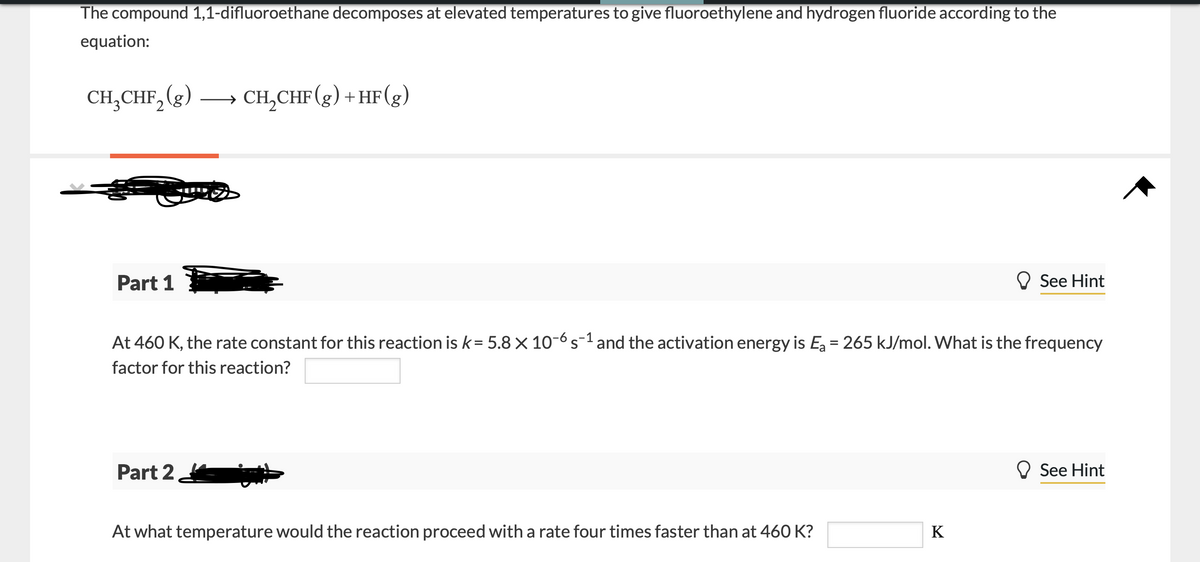The compound 1,1-difluoroethane decomposes at elevated temperatures to give fluoroethylene and hydrogen fluoride according to the equation: CH,CHF, (g) CH,CHF(g) + HF(g) > Part 1 O See Hint At 460 K, the rate constant for this reaction is k= 5.8× 10-6 s-1 and the activation energy is E, = 265 kJ/mol. What is the frequency factor for this reaction? Part 2. O See Hint At what temperature would the reaction proceed with a rate four times faster than at 460 K? K
The compound 1,1-difluoroethane decomposes at elevated temperatures to give fluoroethylene and hydrogen fluoride according to the equation: CH,CHF, (g) CH,CHF(g) + HF(g) > Part 1 O See Hint At 460 K, the rate constant for this reaction is k= 5.8× 10-6 s-1 and the activation energy is E, = 265 kJ/mol. What is the frequency factor for this reaction? Part 2. O See Hint At what temperature would the reaction proceed with a rate four times faster than at 460 K? K
Chemistry & Chemical Reactivity
9th Edition
ISBN:9781133949640
Author:John C. Kotz, Paul M. Treichel, John Townsend, David Treichel
Publisher:John C. Kotz, Paul M. Treichel, John Townsend, David Treichel
Chapter14: Chemical Kinetics: The Rates Of Chemical Reactions
Section: Chapter Questions
Problem 39PS: When healed lo a high temperature, cyclobutane, C4H8 decomposes to ethylene: C4H8(g) 2 C2H4(g) The...
Related questions
Question
100%

Transcribed Image Text:The compound 1,1-difluoroethane decomposes at elevated temperatures to give fluoroethylene and hydrogen fluoride according to the
equation:
CH;CHF, (g)
→ CH,CHF(g) +HF(g)
2
Part 1
O See Hint
At 460 K, the rate constant for this reaction is k= 5.8 X 10-6s-1 and the activation energy is E = 265 kJ/mol. What is the frequency
factor for this reaction?
Part 2
O See Hint
At what temperature would the reaction proceed with a rate four times faster than at 460 K?
K
Expert Solution
This question has been solved!
Explore an expertly crafted, step-by-step solution for a thorough understanding of key concepts.
This is a popular solution!
Trending now
This is a popular solution!
Step by step
Solved in 3 steps

Knowledge Booster
Learn more about
Need a deep-dive on the concept behind this application? Look no further. Learn more about this topic, chemistry and related others by exploring similar questions and additional content below.Recommended textbooks for you

Chemistry & Chemical Reactivity
Chemistry
ISBN:
9781133949640
Author:
John C. Kotz, Paul M. Treichel, John Townsend, David Treichel
Publisher:
Cengage Learning

Chemistry & Chemical Reactivity
Chemistry
ISBN:
9781337399074
Author:
John C. Kotz, Paul M. Treichel, John Townsend, David Treichel
Publisher:
Cengage Learning

Chemistry: The Molecular Science
Chemistry
ISBN:
9781285199047
Author:
John W. Moore, Conrad L. Stanitski
Publisher:
Cengage Learning

Chemistry & Chemical Reactivity
Chemistry
ISBN:
9781133949640
Author:
John C. Kotz, Paul M. Treichel, John Townsend, David Treichel
Publisher:
Cengage Learning

Chemistry & Chemical Reactivity
Chemistry
ISBN:
9781337399074
Author:
John C. Kotz, Paul M. Treichel, John Townsend, David Treichel
Publisher:
Cengage Learning

Chemistry: The Molecular Science
Chemistry
ISBN:
9781285199047
Author:
John W. Moore, Conrad L. Stanitski
Publisher:
Cengage Learning


Chemistry: An Atoms First Approach
Chemistry
ISBN:
9781305079243
Author:
Steven S. Zumdahl, Susan A. Zumdahl
Publisher:
Cengage Learning

Chemistry
Chemistry
ISBN:
9781305957404
Author:
Steven S. Zumdahl, Susan A. Zumdahl, Donald J. DeCoste
Publisher:
Cengage Learning